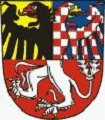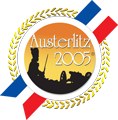 |  |  |
Napoleon Days, 15 to 17 August 2003, Slavkov u Brna – Austerlitz
Town of Slavkov – Austerlitz
Municipality of Tvarožná
Burial Mound of Peace – Austerlitz – OPS
Davay Communications s.r.o.
Central European Napoleonic Society
The event is realized with allowance of – Ministry for regional developement
At the beginning of December 1805 the allied Austrian-Russian army stood against the forces of the French Emperor Napoleon I between Šlapanice and Slavkov. Napoleon’s most famous victory was preceded by a great campaign during which over the course of two months he forced the capitulation of the Austrian army in Bavaria, and its remnants, together with Russian divisions, pressed across all of Lower Austria to Olomouc, in Moravia. Near Olomouc the allies were reinforced by other Russian armies, and their numerical power led the Russian Tsar and the Austrian Emperor, who were present with their armies, to the idea of an offensive advance against Napoleon, regardless of the fact that the powerful army of Archduke Karel was approaching from northern Italy to help out. The allies marched from Olomouc towards Brno, and on 2 December, the anniversary of Napoleon’s coronation, the opposing armies clashed. The allies occupied the line from north of the Olomouc road, through Staré Vinohrady, over the dominant Pratec hill, to the south, near Telnice. Their plan was to breach Napoleon’s right flank with an assault by their left flank and cut him off from his supply lines to Vienna, and to either destroy him or drive him into Bohemia. The two monarchs had about 90,000 troops to accomplish this goal. Their enemy had roughly 15,000 fewer men, but they were far more battle-seasoned. Napoleon fought off the allies’s left flank’s assault at Telnice and Sokolnice with only relatively small divisions, holding most of his army in reserve for the victorious assault he had prepared. The attack came when the allies had nearly abandoned the Pratec hill and were attacking Sokolnice with enormous forces. Marshal Soult’s unit, under the cover of fog, arrived unseen at Prace, fiercely assaulting Staré Vinohrady and Pratec hill, and after a stubborn battle with Austrian and Russian units he occupied his targets. The battle was lost, and even the help of the Russian Guards was in vain. The allies were forced to abandon the battlefield and retreat to Slavkov in disarray. The Austrian-Russian units around Sokolnice were essentially surrounded and forced to surrender. Only small parts of the armies were able to escape over the dykes of frozen lakes. Here one must recall the legend that Napoleon recounted and that lives to this day, according to which thousands of Russian soldiers died in the lakes. In sources documented by the draining of the lakes that was ordered following the battle, only drowned horses and lost military gear were found.
The allied forces had thus suffered a catastrophic defeat in their center and on their left flank. There remained only the Russian unit under General Bagration, who led a relatively isolated battle with the forces of Marshal Lannes near Tvarožná and in the area of the Olomouc road. Even though Bagration also suffered significant losses, he wasn’t routed, and his unit was the only one to retreat in good order.
The allied army was no longer to do battle, and it retreated towards Hodonín and into Hungary. Then on 6 December an armistice was signed in Slavkov Castle, followed by the so-called Treaty of Pressburg, which cost Austria significant territorial losses.
The Battle of Slavkov became a major historical event, and Napoleon himself rated it as the greatest of all the battles he fought.
From 28 June to 19 July 1931 the Slavkov Castle hosted the so-called Napoleonic Exhibition, which was inspired by the entrusting of the heritage of Professor P. Alois Slovák, the founder of the Burial Mound of Peace, to the town of Slavkov. The exhibition, which was organized on the occasion of the 125th anniversary of the Battle of Slavkov and the 120th anniversary of the death of Emperor Napoleon I, was meant as a manifestation in favor of global peace, but the national defense ministry objected to “inappropriate pacifism” and demanded of the exhibition organizers that the main purpose of the exhibition be the emphasis of Czechoslovak-French amity.
The idea of organizing the Napoleonic Exhibition came to light in 1930, and in August of the same year a Napoleonic Exhibition association was founded in Slavkov.Its members acquired many period items from private and national collections and ensured financial support for the entire event from many small businessmen and tradesmen who, in addition, exhibited their products. With the approval of the castle’s owner, Josef Pálffy, the left wing of the castle was used for the Napoleonic part of the exhibition. Visitors were also able to se for the first time paintings from the former collection of the Kounic family, which were installed in the spaces of the castle’s picture gallery. The entire exhibition was set up by the architect Antonín Kuriál.
The exhibition was organized under the patronage of many Czechoslovak and foreign individuals, and members of the Czechoslovak government assumed the status of its protectorate. The foreign part of the honorary board of directors comprised many leading French people, such as Jenniau Achile, the French Consul in Brno, Louis Foucher, the chief of the French mission to Czechoslovakia, and the Madame Denis, the widow of Professor Arnošt Denis. The exhibition opened on 28 June 1931, attended by many important guests. President Masaryk visited it on 5 July of the same year.
On the occasion of the exhibition Slavkov (Napoléon-Austerlitz 1-805-1931) was published, along with the Catalog of the Napoleonic Exhibition, which described all of the exhibits of the Napoleonic part. According to the catalog there were 493 Napoleonic items. The exhibits were placed in twelve halls of the castle, dominated by Napoleon’s bust from the collections of Emma Destinová, and located in the Salla Terrena of Slavkov Castle. The catalog mentioned 187 paintings on display. The second part of the exhibition, which dealt with agriculture, industry, trades, and culture, was placed in the buildings of the municipal and burgers’ school, the Provincial Specialized School of Economics, the Provincial Poultry Farm, and the the Cloister.
The exhibition was a success in every way, and a total of 73,000 Czechoslovak and foreign persons visited it. After it closed it was moved to Prague, where it was organized by the Prague Sample Trade Fairs, and it also enjoyed great success there.
The Slavkov exhibition became the stimulus for a project of the newly built “regional” museum, that was meant to specialize on Napoleonic subjects. The basis of the collections of the new museum were to be some of the exhibits that had been held in the town. These items make up the basis of today’s collection in the Historical Museum in Slavkov u Brna. The new museum was named the Napoleonic Museum, and its origin is attributed to 1932, but it didn’t last long. In the same year the Friends of France Club was founded in Slavkov as well by former members of the exhibition committee, led by Dr. Jaroslav Gregor. According to the club statutes, the main goal was to support visitorship and to develop tourism in the Slavkov area. The club managed the Napoleonic Museum, for which it acquired three rooms in the castle’s left wing. Club members tried to take advantage of the great success of the Napoleonic Exhibition when organizing yet another cultural event, the so-called Napoleonic Games. Napoleonic Games I was organized in 10 September 1933 in the Castle Park, attended by many actors and viewers, and O. Èermák played the part of Napoleon. Because of its great success Napoleonic Games II was organized on 16 June 1935, this time with the participation of about 800 military persons in uniform and civilians in period costumes. This time Bedøich Karen, an actor from the Prague National Theater, played Napoleon, and Dr. Gregor again wrote the scenario. Dr. Edvard Beneš, the Czechoslovak foreign affairs minister, assumed patronage over Napoleonic Games II, along with Bedøich Bradáè, the defense minister, and Emil Naggiar, the French ambassador to Prague.
The Napoleonic Games formed the basis for the so-called memorial events in the 1980s. The participants, in period uniforms, commemorated the events that played out in Slavkov at the beginning of the 19th century. Since the middle of the 1990s the Historical Museum in Slavkov u Brna has been organizing what they call Napoleon Days, which are held in mid-August, i.e., approximately around the time Napoleon was born. They are a “smaller” summer version of the winter memorial events, and they are intended to acquaint the public with a part of Czech and European history in an entertaining form. As the years go by, the program is expanded and supplemented; traditionally a field camp of the Napoleonic and allied armies is set up in the Castle Park, along with a craft fair with a cultural program, an Emperor’s Summer Night, and a petanque tournament. This year the program will be dominated by military history, eliciting the atmosphere of the beginning of the 19th century. Thanks to cooperation with the Austerlitz 2005 Project and C.E.N.S. (Central European Napoleonic Society), over 300 soldiers in period uniforms will camp in the Castle Park, reenacting scenes that preceded the closing of The Austrian-French armistice of 1809. Visitors will be able to observe camp life, including drills, a night march, a clash, and a full military encounter. The Castle will also host costumed tours focusing on Napoleonic themes, and costumed musicians will historical as well as contemporary music during Emperor’s Summer Night. The Napoleon Days are one of the highlights of Slavkov Castle’s summer season, and in cooperation with other institutions, they focus on reviving historical traditions, memories, and events, which should make the region even more attractive to tourists.
Contact:
Projekt Austerlitz 2005, PO Box 38, 616 00 Brno, tel.: 00420 541 148 144, fax: 00420 541 148 141
e-mail: info@austerlitz2005.com
http://www.austerlitz.org
Napoleonic Days
Austerlitz, 15 to 17 August 2003
Military Program
Friday, 15 August
Castle Park
9:00 pm to 10:00 pm – Castle Park – Torch-lit procession
Austrian Armies, solemn ceremony by the grave of the chancellor Kaunitz, at the graveyard
12:00 midnight – Taps, closing of Castle Park
Saturday, 16 August
9:00 am to 10:30 am – Gala entrance of soldiers, ending with a review on the square
10:30 to 12:00 noon – Camp life, units drill in Castle Park
1:00 pm to 3:00 pm – Local exchanges of fire in Castle Park
3:00 pm to 5:00 pm – Battle in the town streets and the Castle Park
9:00 pm to 9:30 pm – Gala march by armies through the town
9:45 pm – Fireworks
9:30 pm to 10:00 pm – Gala entrance of all troops to peace declaration and Napoleon’s birthday celebration
Sunday, 17 August
9:30 am to 11:00 am – Gala entrance, solemn ceremonies near mass graves, ending of the event by the chapel Na Urbánku
Historical Museum Program
Friday, 15 August
Castle Park
7:00 pm to 12:00 midnight – Folk and country music at the Castle
Saturday, 16 August
9:00 am to 10:00 pm – International petanque tournament
9:00 am to 3:00 pm – crafts fair
Programs
Novák’s Small Theater
Grandfather’s courtyard with livestock and period stands with crafts
Fashion show, historical uniforms
Castle
10:00 am to 3:30 pm – Costumes show at Castle Exposition
Castle Courtyard
8:00 pm to 2:00 am – Castle party
Accompanying Programs
16 August – Napoleon Golf Cup 2003 – 2nd annual golf tournament on Austerlitz Golf Club greens
16 August – International petanque tournament – Slavkov Castle
16-17 August – Czech Republic Women’s Beach Volleyball Championship
Project Austerlitz 2005, all rights reserved, The event is realized with allowance of – Ministry for regional developement)